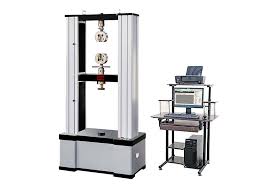Selection and Maintenance of Tensile Testers

Contents
Introduction
When it comes to materials testing, one of the most widely used methods is tensile testing. Tensile testing provides valuable insights into the mechanical properties of materials, helping engineers and researchers make informed decisions. However, selecting the right tensile tester and ensuring its proper maintenance are crucial for accurate and reliable results. In this article, we will explore the selection and maintenance of tensile testers, providing you with essential information to make informed choices.
Understanding Tensile Testing
Tensile testing is a technique used to determine the mechanical behaviour of materials under tensile forces. It involves stretching a sample until it breaks, measuring various parameters such as load, elongation, and stress during the process. By analysing these properties, engineers can assess material strength, ductility, elasticity, and other essential characteristics.
Factors to Consider When Selecting a Tensile Tester
Choosing the right tensile tester is crucial to ensuring accurate and reliable test results. Several factors should be considered during the selection process:
- Load Capacity and Range: Determine the maximum force your testing applications require and choose a tester that can handle the anticipated loads. It’s essential to consider both the maximum and minimum load requirements to accommodate a wide range of materials.
- Speed and Accuracy: Consider the testing speed and accuracy required for your specific applications. Some materials may require slow testing speeds to capture accurate data, while others can be tested at higher speeds without compromising accuracy.
- Gripping Methods: Different materials require specific gripping methods to ensure a secure grip during testing. Consider the availability of suitable grips and fixtures for your intended materials and test specimens.
- Data Acquisition and Analysis: Look for a tensile tester that offers comprehensive data acquisition and analysis capabilities. This includes real-time data monitoring, data logging, and the ability to generate test reports for further analysis.
- Safety Features: Ensure that the selected tensile tester incorporates essential safety features to protect both the operator and the equipment. Safety features may include emergency stop buttons, overload protection, and safety enclosures.
By carefully considering these factors, you can select a tensile tester that meets your testing requirements and provides accurate and reliable results. Right now, the best tensile tester on the market is Testextextile’s Tensile Tester TF001, which is very reliable, fast, and accurate.
Maintenance and Calibration of Tensile Testers
- Regular Cleaning and Inspection: Keep the tester clean and free from dust, debris, and contaminants. Regularly inspect the grips, load cells, and other components for signs of wear or damage. Clean and lubricate the moving parts as recommended by the manufacturer.
- Calibration and Verification: Tensile testers should be calibrated periodically to ensure accurate measurements. Calibration involves comparing the readings of the tester against known standards. It is recommended to follow the manufacturer’s guidelines or consult with a calibration service provider for proper calibration procedures.
- Lubrication and Wear Parts Replacement: Lubricate the moving parts of the tester as per the manufacturer’s instructions. This helps reduce friction and ensure smooth operation. Additionally, replace any worn-out grips, fixtures, or other components to maintain accurate and reliable testing.
By adhering to proper maintenance practises, you can prolong the lifespan of your tensile tester and ensure that it continues to provide accurate and consistent results.
Best Practises for Tensile Testing
To obtain reliable and meaningful results from tensile testing, it is important to follow best practises. Consider the following guidelines:
- Sample Preparation: Carefully prepare the test samples according to the relevant standards or specifications. Ensure that the samples are free from defects or irregularities that may affect the test results.
- Test Procedure: Follow a standardised test procedure, including the application of the appropriate gripping method and testing speed. Adhere to the recommended strain rate and testing conditions for accurate comparisons and consistency.
- Data Interpretation: Analyse the test data properly, considering key parameters such as stress, strain, and load. Interpret the results in relation to the specific material properties of interest, such as yield strength, ultimate tensile strength, or elongation.
By following these best practises, you can ensure accurate and meaningful results from your tensile testing efforts.
Troubleshooting Common Issues
Despite taking precautions, issues may arise during tensile testing. Here are some common problems and their potential solutions:
- Slippage or Misalignment: If the sample slips or becomes misaligned during testing, check the gripping method and ensure proper alignment. Consider using alternative grip types or modifying the gripping technique for better sample stability.
- Inaccurate Results: In the case of inconsistent or inaccurate results, verify that the tester is properly calibrated and maintained. Check for any external factors that may influence the test, such as temperature or humidity. Repeat the test using proper sample preparation and testing conditions.
- Equipment Malfunction: If the tester experiences equipment malfunctions, such as sensor errors or software issues, contact the manufacturer or a qualified service technician for assistance. Do not attempt to repair the equipment yourself unless you have the necessary expertise.
By troubleshooting and addressing these common issues, you can overcome challenges and ensure the reliability of your tensile testing process.
Conclusion
The selection and maintenance of a tensile tester are critical for accurate and reliable tensile testing results. By understanding the importance of tensile testing, exploring different types of tensile testers, considering key factors during selection, and following best practises for testing and maintenance, you can optimise the performance of your tensile testing equipment and obtain meaningful insights into material behaviour.
Incorporating tensile testing into your quality control, research, or manufacturing processes can lead to improved product performance, enhanced material development, and better decision-making.
FAQ 2: Can different grips be used for different materials?
- Yes, different materials may require specific grips to ensure proper gripping and accurate results. Grips are selected based on factors such as material type, shape, and surface characteristics. Consult the manufacturer’s guidelines or seek expert advice to determine the appropriate grips for your specific materials.
FAQ 3: What are the common sources of error in tensile testing?
- Common sources of error in tensile testing include improper sample preparation, misalignment of the sample, gripping issues, equipment calibration problems, and environmental factors such as temperature and humidity. Following proper testing procedures, maintaining equipment, and adhering to industry standards can help minimise errors.
FAQ 4: How long does a typical tensile test take?
- The duration of a tensile test can vary depending on factors such as the material being tested, the testing speed, and the specific test requirements. Tensile tests can range from a few minutes to several hours. It is important to consider the desired data acquisition rate, test speed, and the specific needs of your application.
FAQ 5: Are tensile testers suitable for testing brittle materials?
- Tensile testers can be used to test brittle materials, although special precautions may be necessary due to their unique properties. Care should be taken to prevent sudden failure and ensure accurate measurements. Consider using grips and fixtures specifically designed for brittle materials to minimise sample damage.






